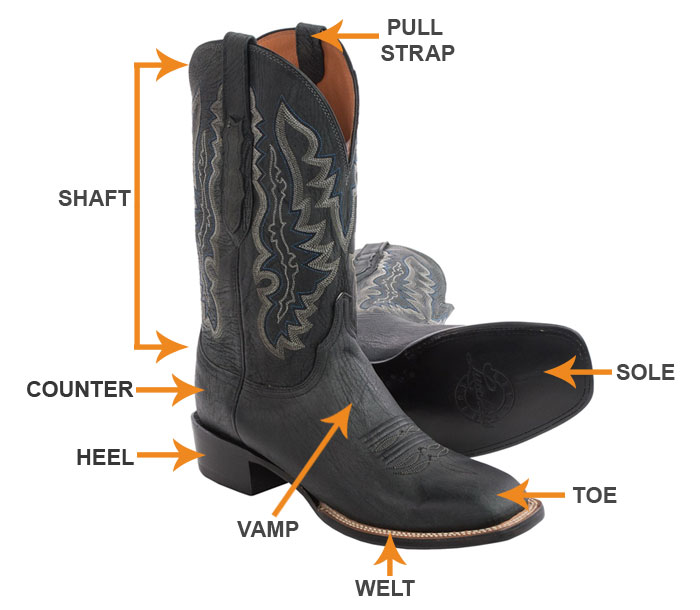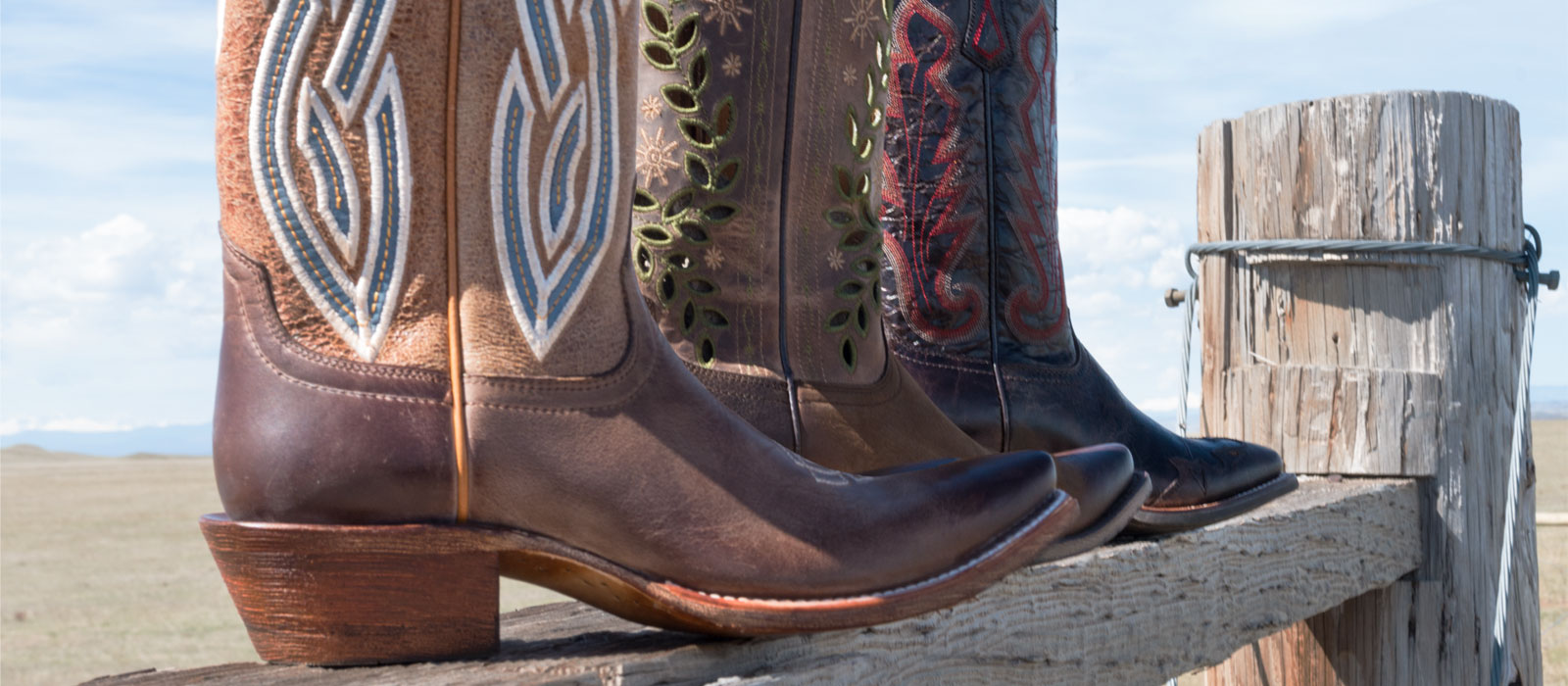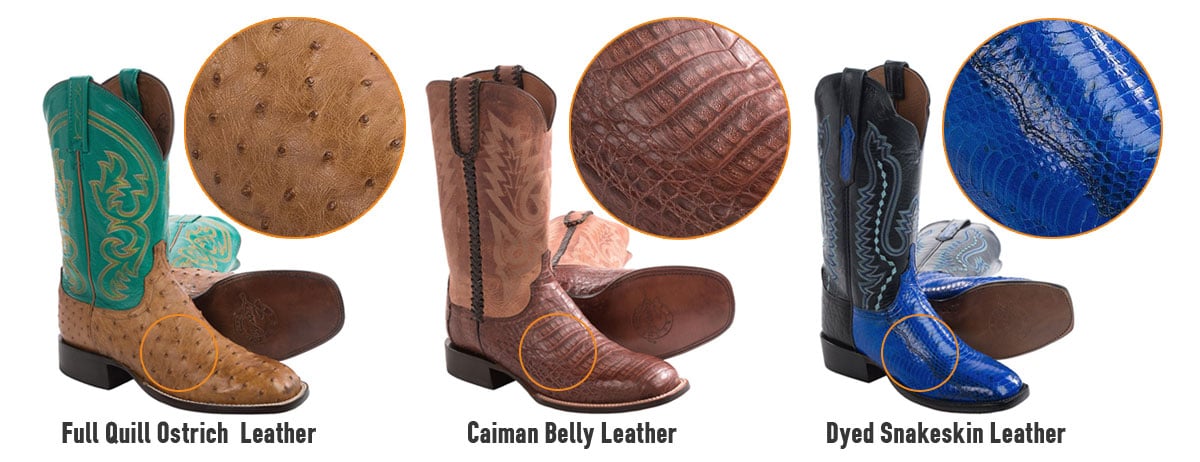
-

Boot Upper
The upper is the exterior structure of a boot, and the uppers of most western boots are crafted of leather. Boot uppers are also formed of several subcomponents, including the following:
- Shaft: The portion of a boot's upper that covers the lower leg and ankle.
- Vamp: The portion of a boot’s upper that covers the forefoot.
- Toe: The foremost portion of a boot’s upper, which covers the toes.
- Counter: The rearmost portion of a boot’s upper, which sits just above the heel.
- Welt: A stitched or bonded seam that attaches the upper to the outsole.
- Heel Cap: The structure that forms the boot’s heel, usually made of compressed leather.
Boot Insole
The insole is a piece of softer material placed inside a boot to provide additional cushioning and comfort. Insoles may or may not be removable, depending on the design. Many western boots have an insole made of softer leather, such as very supple top-grain cowhide.
Outsole and Heel
The sole of most cowboy boots and western boots is crafted of thick, heavy-duty leather. Western work boots may have a rubber outsole for additional traction on slick surfaces. The heel of most boots is made of compressed leather.
Boot Shank
Western boots may or may not have a shank. A boot shank is a semi-stiff piece of material inserted in between the outsole and insole or midsole for additional stability. Typical shank materials include steel, molded nylon or composite.
-

Cowboy Boots
Classic cowboy boots are the most common and iconic of all western boots. These boots have an angled heel of intermediate height (usually an inch-and-a-half or more). This heel type is slightly lower than heels found on true western riding boots, and is ready for riding or walking. The shaft of most cowboy boots usually reaches to about mid-calf, with an overall boot height of about 12 inches. Cowboy boots fall in the middle of the road for western boots, in terms of overall height and heel height. Most cowboy boots are great for sitting in the saddle, kicking up your heels on the dance floor, or everyday wear.
Western Riding Boots
Western riding boots are designed specifically for horseback riding or working in the saddle. These are the favorite boots of many cowboys and cowgirls in rodeos and horse shows. Riding boots have high, angled heels (usually around two inches) to prevent a rider’s feet from sliding through the stirrups. They also have smooth leather soles to prevent snagging in the stirrups in case the rider takes a fall. A tapered toe helps these boots slide in and out of the stirrups more easily. Finally, most western riding boots have a higher shaft (at least mid-calf height) to protect the legs from pinching in the saddle and also protect the rider from brush and thorns.
Ropers
Ropers represent a newer design of Western boots that were created (and so named) to help rodeo cowboys rope calves in competition. The “calf roping” event requires cowboys to ride their horses after a calf to rope it, then to dismount and run down the taut rope to restrain the calf. This event goes far more smoothly with the shorter heels of a roper-style boot. Ropers are similar in style to English riding boots. They have the lowest heel height of all Western boots, usually just over one inch (a heel this low is often referred to as a “walking heel”). The heel is typically squared off, with a 90-degree angle formed between the heel and boot sole. Ropers also have the lowest overall height, with the shaft height being several inches above the ankle. Also, most roper boots have a rounded toe and flexible sole for a more comfortable fit. Some ropers are lace-up boots, which provide a great fit and ankle support but can cause problems if used as riding boots (such as being dragged if thrown from the saddle).
Western Work Boots
Western work boots usually have slightly lower or roper-style heels that are easier on the feet when walking than riding heels. The soles of western work boots are often treaded and have at least some rubber surface for traction, and may have a cushioning midsole for shock absorption. This boot style often costs less than other cowboy boots because the leather used is usually cowhide or another less-exotic material, and less artistry goes into crafting boots designed more for function.
Western Fashion Boots
Western fashion boots come in a wide range of styles and follow virtually no rules. They may be of any height, heel height and design. This is the one western boot style where you will sometimes find synthetic materials used for the shaft, rather than genuine leathers. Also, the most exotic leathers are used for these boots. Many western fashion boots have the taller, knee-high shaft that is commonly seen on performers on stage. Fashion boots may also have an extremely pointed toe and a highly decorated, colorful shaft. Western fashion boots that have the bright colors and retro flair of early Hollywood and Roy Rogers are usually referred to as vintage western boots. We would not recommend using this style of boot for practical purposes like horseback riding or working, but instead for going out on the town.
Summary of Western Boot Types
Boot Type Shaft Height Heel (Height, Shape) Toe (Shape) Lace-Up Sole Relative Cost Cowboy Boots Mid-calf (around 11-12") Around 1½", angled Pointed, flattened or slightly rounded No Smooth leather, may have heel cap Highly variable Riding Boots Mid to upper calf (around 12-13") Around 2", angled Pointed or only slightly rounded No Smooth leather Mid-range Ropers Between ankle and mid-calf (around 7-10") Less than 1½", squared-off "Roper" heel Rounded or squared On some styles Variable, often with tread and traction rubber Low to mid-range Work-Western Boots Mid-calf or lower (around 9-12") 1¾" or less Rounded or slightly tapered On some styles Variable, often with tread and traction rubber Low Western Fashion Boots Variable Usually over 1½", variable Variable On some styles Variable, often with tread Highly variable -
The majority of a western boot consists of the shaft (the part around your leg) and vamp (the leather over and alongside your foot). Together, these areas make up the boot’s “upper.” A western boot upper is almost always made of some form of natural leather, with more traditional cowboy boot uppers being crafted only from smooth cowhide. Western boots come at many different prices, in large part due to the assortment of leathers available today. In terms of actual cowhide, you can go with options like rugged full-grain leather for durability or suede for a scuffed-up look and softer feel. To learn about the properties of various leathers, check out our Guide to Leathers.
Looking for something a little more unique? If you’re willing to pay more, you can find cowboy boots made from a variety of exotic leathers, including alligator, caiman, ostrich, snakeskin, bison or stingray. Just be aware that some of these materials may require special care.

-

Traditional cowboy boots have nearly always been made with a smooth leather sole with a stacked leather heel. This heel-sole combination was (and still is) the best for riding horses with feet in the stirrups. The majority of folks who wear cowboy boots today rarely mount a horse, however, which has led to the availability of many other types of western boot soles and heels. Many modern western boots include a midsole and/ or footbed. This inner layer may be made from materials like spongy synthetic EVA or natural cork, and is designed to cushion the bottom of your foot. Shock absorption and cushioning is especially important if you’ll be walking or standing a lot in your boots.
Sole Types
- Smooth natural leather is best for riding, and also great for line dancing.
- Anti-slip rubber outsoles with tread, often found on roper-style boots, are great for working or lots of walking. Oil-resistant rubber soles are available in some work-Western boots.
- A nice compromise for a Western boot sole is a smooth leather outsole with a rubber-capped heel, providing a small non-slip surface but still allowing for easy movement in and out of stirrups or across the dance floor.
If you want truly handcrafted western boots, look for boots with outsoles that are considered hand-rolled and hand-pegged. All western boot outsoles have a convex curve at the arch to match the shape of a person’s foot. While many modern boot outsoles are rolled by machine to achieve this curved shape, the curve is fashioned by hand in some high-quality boots and secured in place with wooden or brass pegs driven by hand.
Boot Heels

Western boot heel height is largely based on wearer preference, but there are some practical considerations when selecting your ideal Western boot heel height. Lower heels (around one inch) are usually found in ropers and are easiest to walk or work in; higher heels (around two inches) are best for riding… or looking taller! A middle heel height is the most versatile Western boot heel for a combination of riding, walking and working that many cowboys favor. You should buy only boots with authentic stacked leather heels if you want a genuine and durable pair of Western boots. You may want a rubber-capped heel for traction, and you should opt for a lower heel than the traditional two-inch riding heel unless you’re a frequent rider.
Types of Cowboy Boot Toes

The classic cowboy boot has a narrow, pointed toe, designed to slide easily into the stirrups without snagging. In modern times, many western boot wearers rarely (if ever) ride horses, though. As a result, boot manufacturers now offer a variety of toe styles. Below are some common toe styles, listed from most pointed to least pointed:
- J toe: Sharply pointed
- D toe: Tapered toward a point, but with a flat tip
- R toe: Tapered, but rounded at the tip (the most common toe shape in cowboy boots)
- W toe, U toe, Roper toe: Fully rounded or U-shaped
- Square toe: A wide, flat and angular toe
-

Boot Fit
Over the past century, each of the big boot manufacturers have developed their own methods. They use different lasts to mold the boots around, and have individual trade secrets. Therefore you can’t expect standardization of western boot sizes between manufacturers, so you need to know how you fit in a particular brand of boot. To ensure a good fit from your boots, consider the following tips:
- If possible, visit one of our retail stores or another western boot shop and try on several pairs of boots to see how they fit. Pay attention to which boot brands, heels and toe shapes fit and feel best.
- Try boots on in the afternoon when your feet are the largest.
- When trying on boots, wear the same weight (thickness) of socks you would normally wear with boots; usually lightweight to midweight socks.
- Look for a snug fit, especially at the instep (where a pull-on boot is held in place). New western boots should feel snug, but not tight. They will break in over time but won’t stretch a great deal.
- Expect your heel to lift slightly when you walk – about half an inch off the insole of the boot.
- Read our Shoe Fit Guide for more information on how we determine footwear sizing.
Boot Care
Western boots are almost always made of one form of leather or another, but not all boots are made from the same type of leather. Realize that every type of leather has its own unique care requirements. For example, snakeskin boots may require a damp cloth for cleaning, while cowhide cowboy boots may need a polish and shine to look their best. Always follow the care instructions that come with your boots. When properly taken care of, a pair ofcowboy boots can last for many years (or even decades if resoled), and will gain more character and offer a better fit as they go.